Auxiliary analog audio I/O in TesiraLUX
This article demonstrates the capabilities of the analog audio inputs and outputs on the TesiraLUX IDH-1 and OH-1, respectively. The analog audio connections can be used for mic/line level inputs, routed to the audio partition for further processing, and combined with a video stream.
IDH-1
In addition to the embedded PCM audio channels in the HDMI or DisplayPort signal, the IDH-1 includes two balanced mic/line level analog inputs. The pair of analog inputs may be used in a similar way as a Tesira Expander, or the expansion module of a Tesira AVB Amplifier, the key difference being the signal will come in through the AV Input block in the video partition, and will need to be sent to an audio partition by way of a Partition Connector if further signal processing is desired. However, an audio partition is not required. Using the AV Combiner block, the audio from the analog input on an IDH-1 can be combined with any video stream and output to an OH-1 directly without a Tesira audio DSP in the system.

AV Input initialization
The choice between a "Single stereo port" and "Two line ports" is made in the AV Input Initialization dialog. In the example here, I've chosen a Single stereo port that is connected to a PCTx AV block. A two channel AVB stream is created and can be brought into the Audio Partition via a Video to Audio Partition Connector.
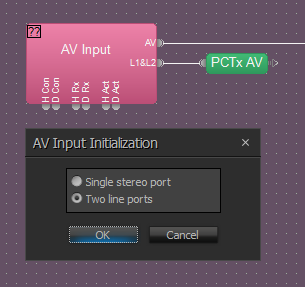
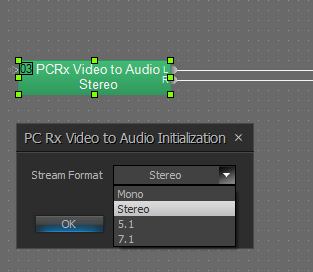
Double click the PCRx Video to Audio block to link the receiver and transmitter. Alternatively, you can link the partitions by using the System View and connecting the Partition Connector Transmit and Receive blocks. The line between the partition blocks are a single stream, but may be multi channel.

Aux Audio Controls
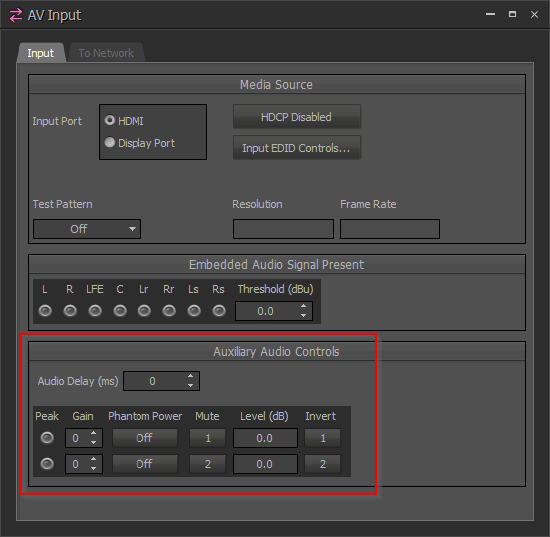 The Auxiliary Audio Controls include Audio Delay (ms), Peak indicator, Gain, Phantom Power, Mute, Level (dB), and phase Invert. All of these functions are provided by the IDH-1, and do not require a Tesira audio DSP.
The Auxiliary Audio Controls include Audio Delay (ms), Peak indicator, Gain, Phantom Power, Mute, Level (dB), and phase Invert. All of these functions are provided by the IDH-1, and do not require a Tesira audio DSP.
Audio Delay is useful for syncing with video sources that have a lot of latency associated with them before they reach the IDH-1, such as a camera. The maximum analog audio delay that can be applied by an IDH-1 is 64 ms. This equates to a maximum of 2 frames at 30hz or 4 frames at 60hz. If more delay is required, the signal can be brought into an audio partition and put through a Delay block.
AEC
The IDH-1 analog inputs can be transmitted to the audio partition and routed through an AEC block. For more information on AEC, see AEC in Tesira.
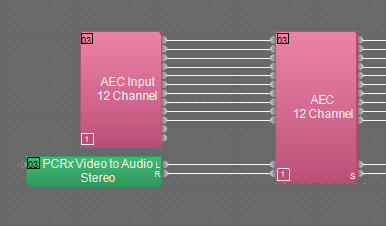
OH-1
 The OH-1 includes two balanced mic/line level analog audio outputs. The pair of analog outputs may be used in a similar way as a Tesira Expander, or the expansion module of a Tesira AVB Amplifier. An audio signal may be brought in via an AVB stream from an audio partition, or the embedded audio straight from the AV Input block.
The OH-1 includes two balanced mic/line level analog audio outputs. The pair of analog outputs may be used in a similar way as a Tesira Expander, or the expansion module of a Tesira AVB Amplifier. An audio signal may be brought in via an AVB stream from an audio partition, or the embedded audio straight from the AV Input block.
AV Output initialization
Like the AV Input block, the AV Output block can be configured with a "single stereo port" or "two line ports" to represent the auxiliary audio outputs.
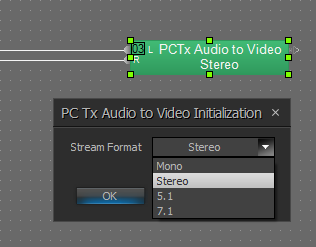
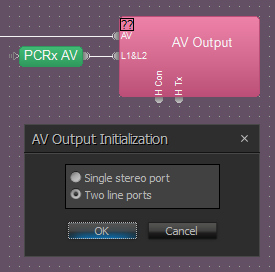
Aux Audio Controls
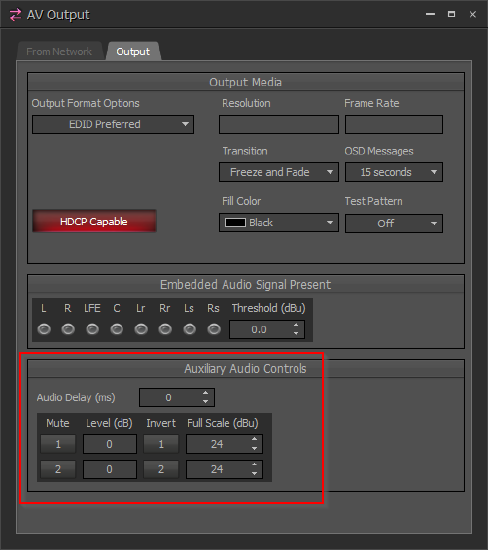 The Auxilliary Audio Controls include Audio Delay (ms), Mute, Level (dB), Invert, Full Scale (dBu). All of these functions are provided by the OH-1, and do not require a Tesira audio DSP.
The Auxilliary Audio Controls include Audio Delay (ms), Mute, Level (dB), Invert, Full Scale (dBu). All of these functions are provided by the OH-1, and do not require a Tesira audio DSP.
The maximum audio delay that can be applied by an OH-1 is 64 ms. This equates to a maximum of 2 frames at 30hz or 4 frames at 60hz. If more delay is required, the signal must be put through a Delay block in an audio partition.
Up-mix and down-mix
The embedded audio from a video source can be directly routed directly to the analog outputs of an OH-1 without routing from an audio partition. The audio will be mixed down appropriately from multi channel stereo/mono.

For more information on how up- and down-mixes are handled in TesiraLUX, see Video to Audio Partition Connections.
Troubleshooting
Tesira Event Logs will indicate talker stream creation and which stream the listener is listening for. Depending on the configuration of the LUX device, we expect to see 4 or 5 streams presented by a LUX IDH-1. The naming is similar to the following:
AV0-V-0 - video stream
AV0-A-0 - HDMI embedded non-restricted audio stream
AV0-R-0 - HDMI embedded HDCP-restricted audio stream
AV0-L_STEREO-0 - the L1&L2 stereo analog audio stream
AV0-L-0 - the L1 mono analog audio stream
AV0-L-1 - the L1 mono analog audio stream
Here is an example from the switch perspective.
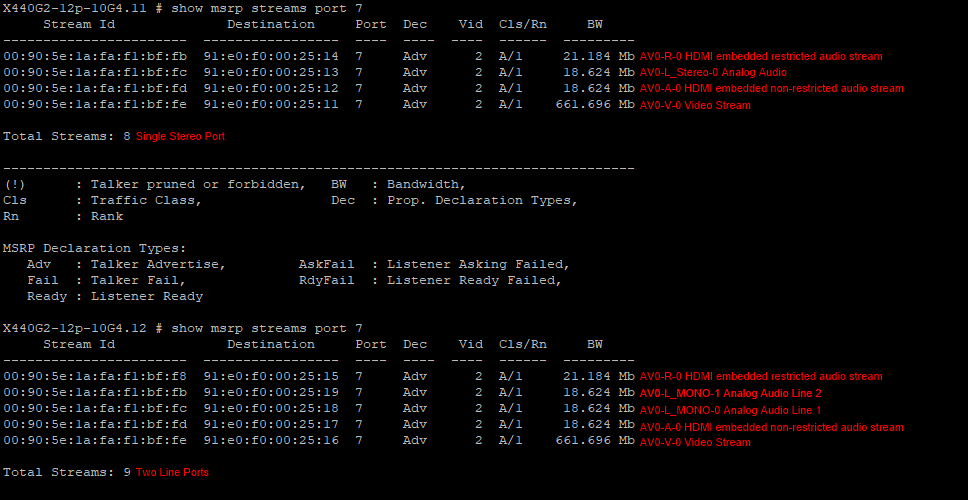
Tesira Event Logs will correlate the stream type with the stream ID as shown below.
| talker stream 'AV0-R-0' [0 90 5E 1A FA F1]:BF:FB talker state Stream ID: 0:90:5e:1a:fa:f1:bf:fb, |
| talker stream 'AV0-V-0' [0 90 5E 1A FA F1]:BF:FF talker state Stream ID: 0:90:5e:1a:fa:f1:bf:ff |
It is worth noting the AV0-R-0 HDMI embedded HDCP-restricted audio stream is only permitted from the HDCP compliant source into LUX IDH-1 and out to LUX devices that have an HDCP compliant display connected. If the file design includes video-to-audio partition connectors for 7.1 or 5.1 audio, the surround sound will be down mixed to stereo audio as defined by HDCP. If the 7.1 or 5.1 surround sound source is not HDCP protected, then all channels can be expected to pass to the audio partition.


